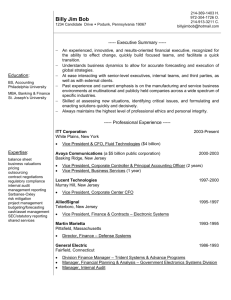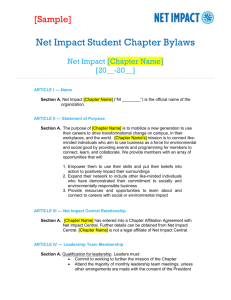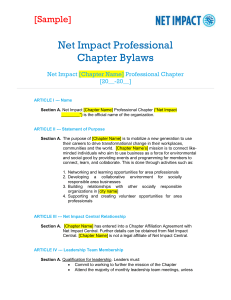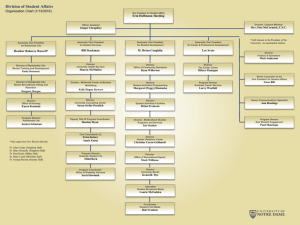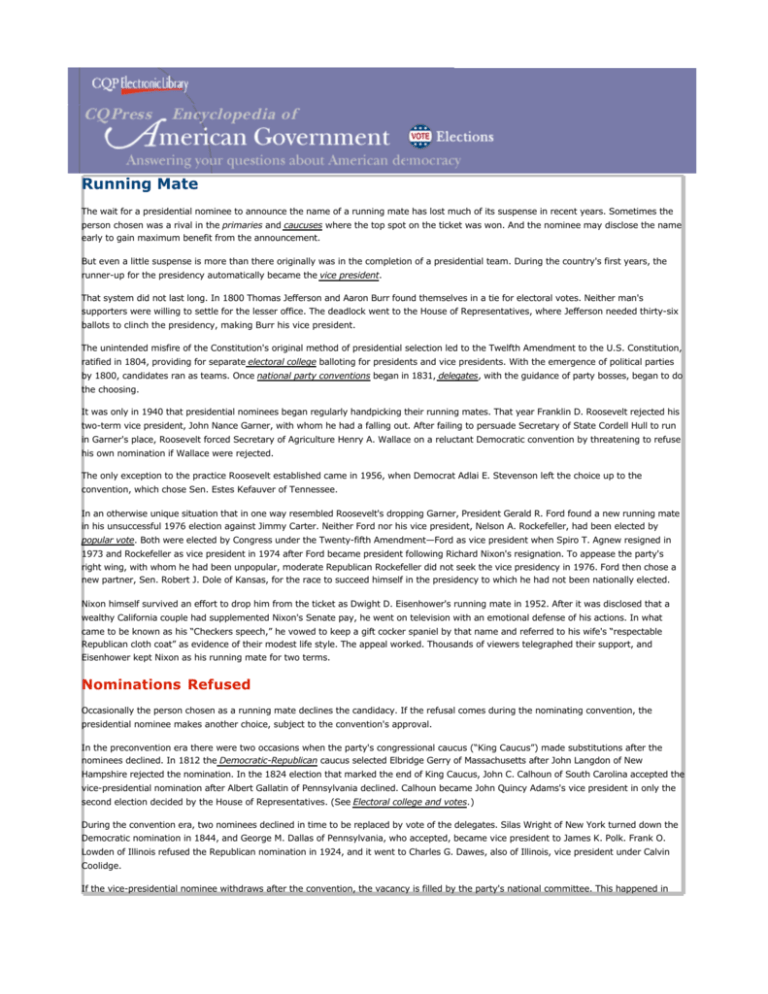
Running Mate
The wait for a presidential nominee to announce the name of a running mate has lost much of its suspense in recent years. Sometimes the
person chosen was a rival in the primaries and caucuses where the top spot on the ticket was won. And the nominee may disclose the name
early to gain maximum benefit from the announcement.
But even a little suspense is more than there originally was in the completion of a presidential team. During the country's first years, the
runner-up for the presidency automatically became the vice president.
That system did not last long. In 1800 Thomas Jefferson and Aaron Burr found themselves in a tie for electoral votes. Neither man's
supporters were willing to settle for the lesser office. The deadlock went to the House of Representatives, where Jefferson needed thirty-six
ballots to clinch the presidency, making Burr his vice president.
The unintended misfire of the Constitution's original method of presidential selection led to the Twelfth Amendment to the U.S. Constitution,
ratified in 1804, providing for separate electoral college balloting for presidents and vice presidents. With the emergence of political parties
by 1800, candidates ran as teams. Once national party conventions began in 1831, delegates, with the guidance of party bosses, began to do
the choosing.
It was only in 1940 that presidential nominees began regularly handpicking their running mates. That year Franklin D. Roosevelt rejected his
two-term vice president, John Nance Garner, with whom he had a falling out. After failing to persuade Secretary of State Cordell Hull to run
in Garner's place, Roosevelt forced Secretary of Agriculture Henry A. Wallace on a reluctant Democratic convention by threatening to refuse
his own nomination if Wallace were rejected.
The only exception to the practice Roosevelt established came in 1956, when Democrat Adlai E. Stevenson left the choice up to the
convention, which chose Sen. Estes Kefauver of Tennessee.
In an otherwise unique situation that in one way resembled Roosevelt's dropping Garner, President Gerald R. Ford found a new running mate
in his unsuccessful 1976 election against Jimmy Carter. Neither Ford nor his vice president, Nelson A. Rockefeller, had been elected by
popular vote. Both were elected by Congress under the Twenty-fifth Amendment—Ford as vice president when Spiro T. Agnew resigned in
1973 and Rockefeller as vice president in 1974 after Ford became president following Richard Nixon's resignation. To appease the party's
right wing, with whom he had been unpopular, moderate Republican Rockefeller did not seek the vice presidency in 1976. Ford then chose a
new partner, Sen. Robert J. Dole of Kansas, for the race to succeed himself in the presidency to which he had not been nationally elected.
Nixon himself survived an effort to drop him from the ticket as Dwight D. Eisenhower's running mate in 1952. After it was disclosed that a
wealthy California couple had supplemented Nixon's Senate pay, he went on television with an emotional defense of his actions. In what
came to be known as his “Checkers speech,” he vowed to keep a gift cocker spaniel by that name and referred to his wife's “respectable
Republican cloth coat” as evidence of their modest life style. The appeal worked. Thousands of viewers telegraphed their support, and
Eisenhower kept Nixon as his running mate for two terms.
Nominations Refused
Occasionally the person chosen as a running mate declines the candidacy. If the refusal comes during the nominating convention, the
presidential nominee makes another choice, subject to the convention's approval.
In the preconvention era there were two occasions when the party's congressional caucus (“King Caucus”) made substitutions after the
nominees declined. In 1812 the Democratic-Republican caucus selected Elbridge Gerry of Massachusetts after John Langdon of New
Hampshire rejected the nomination. In the 1824 election that marked the end of King Caucus, John C. Calhoun of South Carolina accepted the
vice-presidential nomination after Albert Gallatin of Pennsylvania declined. Calhoun became John Quincy Adams's vice president in only the
second election decided by the House of Representatives. (See Electoral college and votes.)
During the convention era, two nominees declined in time to be replaced by vote of the delegates. Silas Wright of New York turned down the
Democratic nomination in 1844, and George M. Dallas of Pennsylvania, who accepted, became vice president to James K. Polk. Frank O.
Lowden of Illinois refused the Republican nomination in 1924, and it went to Charles G. Dawes, also of Illinois, vice president under Calvin
Coolidge.
If the vice-presidential nominee withdraws after the convention, the vacancy is filled by the party's national committee. This happened in
1860 when Benjamin Fitzpatrick of Alabama refused the Democratic nomination and the Democratic National Committee (DNC) replaced him
with Gov. Herschel V. Johnson of Georgia as Stephen A. Douglas's running mate.
In 1912 Vice President James S. Sherman of New York died the week before election day, and the Republican National Committee (RNC)
nominated Columbia University president Nicholas Murray Butler as President William Howard Taft's running mate. It was too late to put
Butler's name on the state ballots, but he received Sherman's eight electoral votes. Taft lost to Woodrow Wilson.
In 1972 Sen. Thomas F. Eagleton of Missouri withdrew as running mate to Sen. George S. McGovern of South Dakota after it was disclosed
that Eagleton had been treated in the past for depression. The DNC gave the nomination to McGovern's substitute choice, R. Sargent Shriver
of Maryland.
Currently, as in the Ford and Rockefeller cases, vacancies in the vice presidency itself are filled under procedures of the Twenty-fifth
Amendment, ratified in 1967. (See Vice president.)
A Once-Maligned Office
If the selection of a running mate often seemed like something of an afterthought, it could be because until recently the position was not
especially coveted. John Adams, the first man to hold the job, once complained, “My country has in its wisdom contrived for me the most
insignificant office that ever the intention of man contrived or his imagination conceived.”
More than a century later, Thomas R. Marshall, Woodrow Wilson's vice president, expressed a similarly dismal view: “Once there were two
brothers. One ran away to sea; the other was elected Vice President. And nothing was ever heard of either of them again.” Still later, Vice
President Garner gave the office its most memorable put-down. It was, he said, “not worth a bucket of warm spit.” (He actually used the
vulgar term for another bodily fluid, but editors thought it unfit for family newspapers.)
Writing in Atlantic in 1974, historian Arthur Schlesinger Jr. suggested the office be done away with. “It is a doomed office,” he commented.
“The Vice President has only one serious thing to do: that is, to wait around for the President to die.” But there is a reasonable chance that
whoever fills the position will get a chance to move up, either by succession or election. As of 2000, fourteen presidents had held the
second-ranking post, seven in the twentieth century.
Also, since the 1970s the vice presidency has evolved dramatically from the somnolent office it once was; during this period five vice
presidents enjoyed responsibility their predecessors did not. President Ford gave Vice President Rockefeller considerable authority in
domestic policy coordination. Walter F. Mondale and George Bush helped to set policy for their respective presidents, Carter and Ronald
Reagan. Bill Clinton placed Al Gore in charge of a “reinventing government” task force and gave him broad responsibilities over environmental
issues. Elected in 2000, President George W. Bush granted his vice president, Richard B. Cheney, perhaps the most sweeping powers of all.
Cheney, a former representative who also served as White House chief of staff under Ford and secretary of defense in the first Bush
administration, emerged as a major player on foreign policy and energy issues. He was, in some respects, the president's most influential
advisor.
Factors in Selection
Whoever is selected as a running mate is scrutinized not so much as a policy maker, but for how well the choice balances (or unbalances)
the ticket. One important factor is geography, which Clinton of Arkansas used unconventionally in choosing Gore of neighboring Tennessee to
form the first successful all-southern ticket in 164 years.
Other traditional factors weighed by nominees are religion and ethnicity. In 2000 Gore selected Joe Lieberman of Connecticut, the first
Jewish vice-presidential candidate of a major party. Race, gender, and age also play a role. In 1984, for example, the Democrats chose Rep.
Geraldine A. Ferraro of New York to be their vice-presidential candidate, the first woman to receive a major-party nomination.
Although no African American has so far been selected by either party, many Democrats thought that Jesse L. Jackson deserved second
place on the ticket in 1988. Jackson had received 29 percent of the primary vote to 43 percent for Michael Dukakis. Instead, the
fifty-four-year-old Dukakis chose Sen. Lloyd Bentsen of Texas, then sixty-seven, balancing the Democratic ticket by age as well as
geographically and philosophically.
George Bush selected Sen. Dan Quayle of Indiana, a choice that proved extremely controversial, even among Republicans. Quayle, born in
1947, had served two terms in the House of Representatives before his election to the Senate in 1980. The brevity of his experience in
politics and his avoidance of Vietnam War duty by serving in the Indiana National Guard fostered doubts that he was qualified to serve as
president, should that become necessary. However, Quayle was young and good looking, and the two swept to victory in November.
For his 1992 running mate, Clinton, in another unbalancing act, selected someone in his own age group (forty-six versus forty-four for Gore)
rather than an elder statesperson like Bentsen, who became secretary of the Treasury in the first Clinton administration. In 1996 Clinton and
Gore became the first Democratic running mates to win reelection since Roosevelt and Garner in 1936. (Although FDR was reelected in 1940
and 1944, it was with two different vice presidents. He abandoned Wallace in 1944 in favor of Harry S. Truman.)
In many respects, Bush's selection of Cheney in 2000 was also unconventional. Cheney, as with Bush, was a conservative with ties to the
oil industry, and he came from Wyoming, a state with little impact on the electoral college. But Bush, who had no national experience, was
looking for a Washington veteran. Cheney performed well on the campaign trail, projecting a solid and thoughtful presence.
The Twelfth Amendment prohibits any one state from monopolizing the presidency and vice presidency. In roundabout fashion the
amendment requires the electors to “vote by ballot for President and Vice President, one of whom, at least, shall not be an inhabitant of the
same state with themselves.” No matter what state has the winning president or vice president, the electors there must vote for an
outsider for one of the two offices. As a result of that amendment, Cheney in 2000 was obliged to change his official residency from Texas,
where he was working at the time Bush selected him, to Wyoming, where he had spent much of his life (See Vice president.)
Document Citation
Moore, J. L. (2003). Running mate. In Elections a to z, 2nd ed. Washington: CQ Press. Retrieved October 15, 2008, from CQ Electronic
Library, CQ Encyclopedia of American Government, http://library.cqpress.com/eag/elaz2d-156-7494-402904. Document ID:
elaz2d-156-7494-402904.
Document ID: elaz2d-156-7494-402904
Document URL: http://library.cqpress.com/eag/elaz2d-156-7494-402904
© 2003, 2008, CQ Press, A Division of SAGE Publications. All Rights Reserved.
2300 N Street N.W., Suite 800 • Washington, D.C. 20037 • 202-729-1800
General Terms of Service | Copyright Notice and Takedown Policy | Masthead



